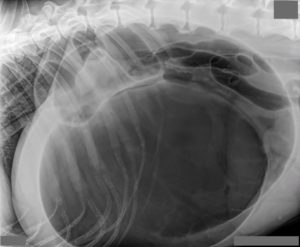Gastric Dilation and Volvulus
What is GDV?
Gastric dilation and volvulus (GDV) or “bloat”, is a life-threatening condition that requires emergency surgery, and even with surgery, can result in death. The stomach twists in a clockwise direction as it becomes distended. The inlet to the stomach from the esophagus and the outlet leading into the duodenum get kinked off and the food, fluids, and air cannot pass in either direction. As a result, unproductive retching occurs. This is one of the more common symptoms of GDV.
Due to the twisting and displacement of the stomach, the blood supply may be cut off and a portion or all of the stomach may die. The longer that the stomach has been twisted before treatment is provided, the greater the risk that the stomach will die.
Another event that occurs is occlusion of the main vein (vena cava) leading from the back half of the body to the heart and resultant shock. Shock, a condition in which there is inadequate perfusion of the body with blood, is fatal if not treated. Signs of shock include pale gums, rapid heart rate, and weak pulses (low blood pressure). Dogs that develop GDV generally are quite ill and need immediate aggressive treatment. Emergency decompression of the stomach and surgical tacking of the stomach to the body wall is necessary

The survival rate following surgery is about 90% if the stomach is not devitalized. If a portion of the stomach has died off, the survival rate is about 50%, in spite of medical and surgical treatment
While GDV can happen in any dog, we see it most commonly in large and giant breed dogs with deep chests, such as Great Danes, German Shepherds, Blood Hounds, Irish Setters, Irish Wolfhounds, Standard Poodles, and Weimeraners. Great Danes are at very high risk and research has shown that one in four Danes will bloat in their lifetime.
Prophylactic gastropexy is a preventative surgery aimed at preventing GDV from occurring by tacking the stomach to the body wall. This is accomplished using minimally invasive techniques (two small incisions and the assistance of cameras that look inside the abdominal cavity) and can be performed at the time of spay or neuter. We recommend this procedure for any large or giant breed dog that may be at risk, particularly those dogs that have a history of “food bloating” and/or have a relative that has had GDV. This procedure has minimal morbidity, less anesthesia and surgery time, short hospital stay (done as an outpatient surgery), and is less expensive than treating GDV.